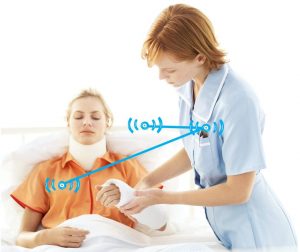
Recently, I was emailing with a colleague who uses 3D printing for prototyping at his job. The company he works for makes healthcare related wireless devices. They prototype these devices using 3D printing to ensure their mechanical soundness and usability, before having them manufactured.
On probing a bit more, I found that his company provides Real-Time Locating System (RTLS) solutions for hospitals. RTLS is a local positioning system where small, inexpensive electronic tags are attached to people and objects, such as equipment, patients and caregivers in a hospital, to help track interactions and improve services.
This means hospitals can better track when doctors and nurses entered the room, interacted with the equipment and patient etc. This non-intrusive logging means that the system could alert nurses when a patient hasn’t been checked on for a while. It could also be used for better asset-tracking; Hospital staff no longer need to manually log every time a piece of equipment moves rooms, but can locate equipment instantly even in large hospitals. Tags on the patient’s wrist can pull up their electronic medical records immediately and accurately, reducing the risk of dangerous errors.
The ability to do communications this way – with no recharging, changing batteries, or worrying about the thing – really changes the game. – Gary Jorgensen, Awarepoint

All this is done through small, wireless tags that are low-power and need no recharging for the life of the tag. I wrote earlier on why I think the no recharging aspect is important. My colleague, Gary Jorgensen, concurs, “Our products run 3-5 years (we’re Zigbee based) off a single coin cell battery, which is usually the obsolescence life of a product anyway. The ability to do communications that way – with no recharging, changing batteries, or worrying about the thing – really changes the game.”
I think this kind of system is a good start for UbiComp in the real world. The system is non-intrusive in that it doesn’t require users to change their behaviour, but instead integrates into their environment and provides benefit through improving patient care and reducing risks and errors. The tags are small, need no maintenance and easily integrated into wristbands, asset management tags etc. The basestations for talking to them are simple devices that can be plugged directly into a wall socket.

In the hospital environment, it’s reasonable for all machines and people to wear tags, badges and wristbands. However that’s not so true at home – the first thing I do when I get home is rip off my work badge! Would I really be willing to wear a home badge? Still, there are ways in which this technology can be used for home automation. At the very least, sensors can detect environmental features like light, humidity and temperature and report to a main home system. You could get tweeted if your basement floods, or if your lights are unexpectedly turned on while you are not at home.
What kinds of uses do you see for this kind of technology?
What kinds of privacy issues could it bring up in a non-hospital scenario?

